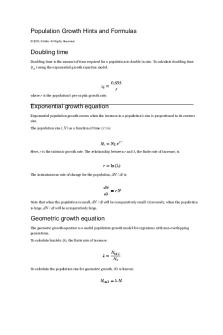Population Growth Hints and Formulas Sheets PDF

| Title | Population Growth Hints and Formulas Sheets |
|---|---|
| Course | Ecology |
| Institution | Mercer University |
| Pages | 3 |
| File Size | 149.4 KB |
| File Type | |
| Total Downloads | 81 |
| Total Views | 147 |
Summary
Population Growth Hints and Formulas Sheets...
Description
Population Growth Hints and Formulas © 2020, SimBio. All Rights Reserved.
Doubling time Doubling time is the amount of time required for a population to double in size. To calculate doubling time (t d ) using the exponential growth equation model:
where r is the population's per-capita growth rate.
Exponential growth equation Exponential population growth occurs when the increase in a population's size is proportional to its current size. The population size ( N ) as a function of time ( t ) is:
Here, r is the intrinsic growth rate. The relationship between r and λ, the finite rate of increase, is:
The instantaneous rate of change for the population, dN / dt is:
Note that when the population is small, dN / dt will be comparatively small. Conversely, when the population is large, dN / dt will be comparatively large.
Geometric growth equation The geometic growth equation is a useful population growth model for organisms with non-overlapping generations. To calculate lambda (λ), the finite rate of increase:
To calculate the population size for geometric growth, if λ is known:
The generalized form of the geometric growth equation is:
Here, λ is the population's finite rate of increase (per time unit).
t is time. N t is the population size at time t N t+1 is the population size at time t + 1 N 0 is the initial population size, at time 0.
Logarithms A logarithm is the exponent to which a base must be raised to produce a given number. For example, since 43 = 64, then 3 is the logarithm of 64 with base 4. And 3 is the exponent to which 4 must be raised to produce 64. We can write this relationship thus: 3 = log464. log464 = 3 is called the logarithmic form. 43 = 64 is called the exponential form. Common logarithms have 10 as their base. When the base is not indicated, you can assume base 10. For example, log 100 = 2 because 102=100. Natural logarithms have what's called "e" as their base. The value of e is approximately 2.7183. The notation "ln" indicates a natural log. In logarithmic form:
ln 2 = log e 2 = 0.693 In exponential form:
e 0.693 = 2 A scientific calculator will usually have a "log" button that will give you the logarithm for base 10, and a "ln" button that will give you the logarithm for base e.
Logistic Growth Equation Logistic growth is a model of population growth in which population growth rate (dN/dt) declines as the population size increases and approaches its maximum possible size (its carrying capacity, K). If the population size is larger than K, growth is negative and the population shrinks. The logistic growth equation models population growth in the presence of a limiting resource. The equation is:
where r is the intrinsic growth rate, K is carrying capacity, and N is population size.
Metapopulation Equation For a metapopulation, the change in the proportion of occupied patches, P, over time is described by the equation:
where:
c is the patch colonization rate, determined by how many emigrants move from occupied patches to successfully colonize empty patches, and
e is the patch extinction rate, describing the likelihood that an existing subpopulation will go extinct in one time period.
Population size (N) at time t N t is the size of the population, N, at some time, t. The subscript "t" can be any time (week, year, etc.) from t = 0 upwards: it indicates that the value of N is the size of the population at that time. For example, N 14 is the population size at t = 14. Sometimes the subscript x is used instead of t. The meaning is the same.
N t+1 is the size of the population one time period (year, week, etc.) after time t....
Similar Free PDFs

Population Growth -
- 1 Pages

Global Population and Mobility
- 4 Pages

Business Creation and Growth
- 29 Pages

HINTs - Vestibular
- 5 Pages

Growth and Development Notes
- 10 Pages

Human growth and development
- 46 Pages

Growth and development chart
- 9 Pages

Hints 09 - WEI Xiaoyu
- 2 Pages

CH. 2 Population and Health
- 7 Pages
Popular Institutions
- Tinajero National High School - Annex
- Politeknik Caltex Riau
- Yokohama City University
- SGT University
- University of Al-Qadisiyah
- Divine Word College of Vigan
- Techniek College Rotterdam
- Universidade de Santiago
- Universiti Teknologi MARA Cawangan Johor Kampus Pasir Gudang
- Poltekkes Kemenkes Yogyakarta
- Baguio City National High School
- Colegio san marcos
- preparatoria uno
- Centro de Bachillerato Tecnológico Industrial y de Servicios No. 107
- Dalian Maritime University
- Quang Trung Secondary School
- Colegio Tecnológico en Informática
- Corporación Regional de Educación Superior
- Grupo CEDVA
- Dar Al Uloom University
- Centro de Estudios Preuniversitarios de la Universidad Nacional de Ingeniería
- 上智大学
- Aakash International School, Nuna Majara
- San Felipe Neri Catholic School
- Kang Chiao International School - New Taipei City
- Misamis Occidental National High School
- Institución Educativa Escuela Normal Juan Ladrilleros
- Kolehiyo ng Pantukan
- Batanes State College
- Instituto Continental
- Sekolah Menengah Kejuruan Kesehatan Kaltara (Tarakan)
- Colegio de La Inmaculada Concepcion - Cebu






